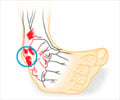- SKIER’S THUMB FAQ - (http://handsurgery.org/multimedia/files/public/skierthumb.pdf)
- Skiers thumb Diagnosis - (http://myhand.com.au/handouts/region/thumb/235-skiersthumb-diagnosis-thumb)
- Skier's thumb - aftercare - (https://www.nlm.nih.gov/medlineplus/ency/patientinstructions/000572.htm)
- How to prevent and treat skier’s thumb - (http://boyslife.org/outdoors/wilderness-first-aid-qa/36390/how-to-prevent-and-treat-skiers-thumb/)
- Skier's thumb - (http://www.bssh.ac.uk/patients/commonhandconditions/skiersthumb)
What is Skier’s or Gamekeeper’s Thumb?
Skier’s thumb, also known as gamekeeper’s thumb, is a condition that occurs due to tearing of the ulnar collateral ligament (UCL) of the thumb. It is known as skier’s thumb because it is mainly seen in skiers who fall holding the ski pole in their hand. It is also observed among sportspersons who play contact sports like rugby, cricket, football and wrestling.
The ulnar collateral ligament of the thumb is located on the inner aspect of the joint at the thumb base when the hand is kept facing forward and the fingers pointing downwards. Its function is to impart support and stability to the thumb when pinching or gripping.
Skier’s thumb is an acute condition and the tear of the ulnar collateral ligament (UCL)can be partial or complete due to a sudden and forced stretching of the thumb in an outward direction.
Treatment depends on the type of tear treatment is advised. A partial tear requires generally a conservative treatment whereas a complete tear will mean a surgical treatment for the best results. With proper rehabilitation, people with skier’s thumb can return to their work and even ski very soon.
This condition is also called Gamekeeper#$#s thumb when the hyperabduction injury of the thumb is more low grade and chronic. In this condition the injury to the thumb is gradual and repetitive and results in thinning of the ligament.
The term was coined by an orthopedic surgeon called Dr.C.S. Campbel in 1955. He noticed this condition in Scottish gamekeepers. The injury appeared to occur as a result of the peculiar method in which they killed small animals such as rabbits; the animals were placed on the ground, and their necks were broken as the gamekeeper exerted downward pressure with the thumb and index finger. This method resulted in undue force upon the abducted metacarpophalangeal (MCP) joint. Over time, this would lead to insufficiency of the ulnar collateral ligament (UCL) of the thumb. Others noted gamekeepers would also carrying home their game in a leather thong, which they would attach to their thumb and drape over their shoulder.
What are the Causes of Skier’s or Gamekeeper’s Thumb?
Skier’s thumb injury occurs due to a sudden and strained stretching of the thumb in the outward direction. This may happen due to:
- A fall on an outstretched hand with the ski pole held in the palm of the hand
- Automobile accident when the driver has the thumb alone placed on the steering wheel of the vehicle.
- Awkward fall on outstretched hand
- Sports injury due to trying to take a difficult catch in cricket or due to any other ball sports
What are the Symptoms & Signs of Skier’s or Gamekeeper’s Thumb?
The signs and symptoms of Skier’s thumb are as follows:
- Pain at thumb base. The pain may be experienced at the wrist in some cases
- Swelling and bruising on the inner side of the joint at the base of the thumb.
- Instability and pain during movements of the thumb
- Inability or weakness in the grasp objects between the thumb and the index finger
- Difficulty throwing objects
- Difficulty with holding items like pen or pencil when performing writing
How is Skier’s or Gamekeeper’s Thumb Diagnosed?
Skier’s thumb is diagnosed based on history of injury at the thumb, physical examination, and imaging tests.
Examination of the thumb reveals a swollen and bruised base of the thumb. Pain will be elicited by pressing the area. The joint is unstable on movement.
An X-ray can be taken to check any bone injury; the ligament tear is sometimes accompanied by separation of a small piece of bone, which can be noted on x-ray.
Special Ultrasound scan or a CT scan or an MRI scan may be recommended in some cases.
How is Skier’s or Gamekeeper’s Thumb Treated?
First Aid or Home Care for the Injury
- Ice should be applied to reduce swelling for about 20 minutes every hour for the first 24 to 48 hours
- Acetaminophen or ibuprofen may be taken to reduce pain
- Splint or cast or restrict movements of the thumb as much as possible to lessen the pain
Consulting an Orthopedic Doctor
If the doctor notices that the patient has a skier’s thumb, then he will refer to a hand surgeon or an orthopedic surgeon. The surgeon will examine the thumb and accordingly will discuss surgical or non-surgical therapy options with you.
Conservative Treatment
An incomplete tear or sprain of the ulnar collateral ligament (UCL) can be treated without surgery by immobilizing the joint with a spica splint for a duration of six weeks. Exercises for the joint are advised following removal of the splint. It can take many months for your thumb to make full movements and recover the lost strength.
Surgical Treatment
If there is a complete tear of the ligament, surgery will be required to repair the ligament with sutures. The surgery can be performed under general anesthesia or local anesthesia. If a small part of the bone is chipped off, it can be re-fixed with a small screw or wires. After the surgery, splinting followed by exercise to the joint will be advised.
Health tips:
- Skiers should remember to discard the ski pole during all falls while skiing. A ski pole without a restraining device like a wrist strap should preferably be used. Wear a thumb stabilizer to safeguard the ulnar collateral ligament, without restricting hand movements and functions.
- While driving keep your thumbs on the outside of the steering wheel along with your fingers.
- Be careful while walking over slippery and wet floors.









